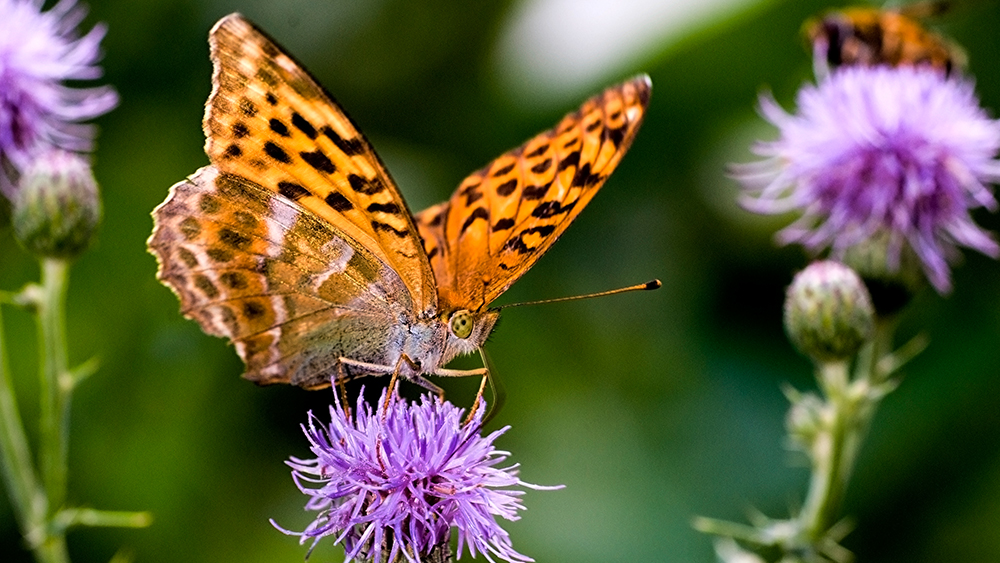The takeoff and flight of butterflies has long been derided by evolutionists as being an unstable and inefficient product of evolution. However, a new study has shown that the spectacular complexity and efficiency of butterfly wing design is an optimized system worthy of emulating in a new generation of flying robotic drones.1
Butterflies fluttering around a sunny garden grab our curiosity and fascinate us like no other creature. In fact, butterflies look like no other flying animal because they have such unusually broad and large wings relative to their small body size. Thus, secular scientists have been mystified as to how this specific type of flight could have come about. When evolutionary scientists first began to study butterfly wings, they claimed that they utilized unsteady aerodynamic mechanisms and that the upstroke of the wings, known as wing clap, was a particularly inefficient feature.
In this new study, which was considerably more high-tech than previous projects, scientists analyzed the wing action and aerodynamics of a type of butterfly called the silver-washed fritillary (Argynnis paphia). They used a technique called tomographic particle image velocimetry which measures the velocity of objects in three dimensions. They also applied a mechanical analysis called kinematics which defines the motion of an object without any reference to the forces which cause it. The data for these analyses was obtained by the high-speed filming of butterflies during take-off and flight in a specialized wind tunnel.
The results of the research were startling. Other free-flying creatures, including other types of insects, lack the unique type of mechanism observed, so the wing design of the butterfly was totally unexpected. During an upward stroke, the optimized design of the flexible wings produces a specialized cavity that creates an air-filled pocket. As the wings continue to compress, the air is forced out like a jet engine, propelling the butterfly forward. The downward wing stroke has yet another purpose: stabilizing the flight pattern and keeping the butterfly in the air. Not only does this mechanism allow for efficient flight, but it also allows for rapid takeoff when the butterfly needs to escape a predator.
When they compared their butterfly data to that of insects with more rigid wings, the researchers were able to demonstrate an increase in forceful impulse of more than 22% combined with an increase in overall efficiency of more than 28%. One must also consider that this boost in power and efficiency would also likely contribute to overall resilience. For example, the Monarch butterfly makes a lengthy migration across North America where it has been shown to fly 50 to 100 miles per day.
Needless to say, this fabulous wing engineering was immediately scrutinized for its potential to benefit mankind. The authors of the paper stated, “Furthermore, our findings could aid the design of man-made flapping drones, boosting propulsive performance.”1
However, as is the norm in secular research publications, no credit or glory was given to our mighty Creator, the Lord Jesus Christ, whose handiwork was clearly revealed. As the Bible says, “For since the creation of the world His invisible attributes are clearly seen, being understood by the things that are made, even His eternal power and Godhead, so that they are without excuse, because, although they knew God, they did not glorify Him as God, nor were thankful, but became futile in their thoughts, and their foolish hearts were darkened.”2
References
1. Johansson, L.C., and P. Henningsson. 2021. Butterflies fly using efficient propulsive clap mechanism owing to flexible wings. Journal of The Royal Society Interface. 18 (174): 20200854. DOI: 10.1098/rsif.2020.0854.
2. Romans 1:20.
*Dr. Tomkins is Director of Research at the Institute for Creation Research and earned his doctorate in genetics from Clemson University.

Butterfly Wing Design Repudiates Evolution
The Latest
Puzzling Fossils at an Unlikely Time
Wherever and whenever life is found, it is incredibly complex. This certainly applies to cyanobacterial photosynthetic life that supposedly were some...
CREATION PODCAST
A Theory Designed to Be...Anti-Design | The Creation Podcast:...
Science is objective. At least, that’s what we’re told. But there are inherent issues with this statement that can...
Seeing the Case for Creation in Fruit Flies
Our brain is designed to smoothly and constantly process what we see via the incredibly sensitive photoreceptors (cones and rods) of our eyes.1...
Amazing Defense Systems
Bacteria (prokaryotes) are ubiquitous. A fraction cause disease in people, animals, and plants, but the majority are the foundation for the global food...
Octopus and Fish Plan a Complex Coordinated Hunt
The octopus—an invertebrate—never fails to surprise researchers with its incredible abilities.1,2
The octopus was designed...
A ''40 million year old'' 100% European Gnat
Finding well-preserved creatures in amber1 is a landfall for creation scientists, much like the numerous discoveries of soft dinosaur tissue...
CREATION PODCAST
The Undeniable Power of Narrative | The Creation Podcast: Episode...
Science is objective. At least, that’s what we’re told. But there are inherent issues with this statement that can cause...
Paintbrush of the Creator
Who doesn’t enjoy the amazing color patterns of butterflies?1,2 Such beautiful designs and construction do not reflect blind naturalistic...
November 2024 ICR Wallpaper
"Rejoice always, pray without ceasing, in everything give thanks; for this is the will of God in Christ Jesus for you." (1 Thessalonians 5:16-18 NKJV)
ICR...





















